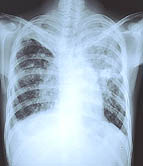- Double Mastectomy May Offer No Survival Benefit to Women With Breast Cancer
- Toxic Lead Found in Cinnamon Product, FDA Says
- Certain Abbott Blood Sugar Monitors May Give Incorrect Readings
- Athletes Can Expect High Ozone, Pollen Counts for Paris Olympics
- Fake Oxycontin Pills Widespread and Potentially Deadly: Report
- Shingles Vaccine Could Lower Dementia Risk
- Your Odds for Accidental Gun Death Rise Greatly in Certain States
- Kids From Poorer Families Less Likely to Survive Cancer
- Tough Workouts Won’t Trigger Cardiac Arrest in Folks With Long QT Syndrome
- At-Home Colon Cancer Test Can Save Lives
Could Stem Cells Cure Drug-Resistant Tuberculosis?


A patient’s own bone marrow stem cells might someday be used to treat multidrug-resistant tuberculosis, a new study suggests.
The phase 1 study to assess the safety of the treatment included 30 patients, aged 21 to 65, with multidrug-resistant tuberculosis or the even more dangerous extensively drug-resistant tuberculosis. They received standard tuberculosis antibiotic treatment and an infusion of about 10 million of their own bone marrow stem cells.
A comparison group of 30 patients with either type of tuberculosis received standard treatment only.
After 18 months, 16 patients treated with bone marrow stem cells were cured, compared with five patients in the standard group, the study authors said. The most common side effects in the stem cell group were high cholesterol (14 patients), nausea (11), and lymphopenia (low white blood cell count) or diarrhea (10).
There were no serious side effects, according to the study, which was published Jan. 8 in The Lancet Respiratory Medicine.
Conventional treatment for multidrug-resistant tuberculosis uses a combination of antibiotics that can cause harmful side effects in patients, study leader Markus Maeurer, a professor at Karolinska University Hospital in Sweden, said in a journal news release.
“Our new approach, using the patients’ own bone marrow stromal cells, is safe and could help overcome the body’s excessive inflammatory response, repair and regenerate inflammation-induced damage to lung tissue, and lead to improved cure rates,” Maeurer said in the news release.
Longer follow-up with more patients is needed to confirm the safety and effectiveness of the stem cell therapy, he said.
About 450,000 people in Eastern Europe, Asia and South Africa have multidrug-resistant tuberculosis, and about half of them will not respond to existing treatments, according to the World Health Organization.
More information
The American Lung Association has more about multidrug-resistant tuberculosis.
Source: HealthDay
Copyright © 2024 HealthDay. All rights reserved.










